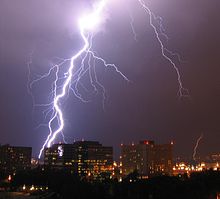 Thunderstorm asthma? This is an asthma attack triggered by a thunderstorm - it is still relatively rare, but predicted to increase with the coming climate changes. During thunderstorms there are downdrafts of cold air which sweep up particles of pollens and mold spores into the clouds. There they absorb moisture and rupture into small, fragments (into a size easily inhaled into the lungs), which then are dispersed by rain and wind. When inhaled they can enter the lungs and trigger an asthma attack - thunderstorm asthma. [Note that normally larger pollen grains are usually filtered by hairs in the nose - so they don't make it to the lungs.] It seems that people with "hayfever" and allergies to grass pollen are at highest risk - at least in Australia. From Medscape:
Thunderstorm asthma? This is an asthma attack triggered by a thunderstorm - it is still relatively rare, but predicted to increase with the coming climate changes. During thunderstorms there are downdrafts of cold air which sweep up particles of pollens and mold spores into the clouds. There they absorb moisture and rupture into small, fragments (into a size easily inhaled into the lungs), which then are dispersed by rain and wind. When inhaled they can enter the lungs and trigger an asthma attack - thunderstorm asthma. [Note that normally larger pollen grains are usually filtered by hairs in the nose - so they don't make it to the lungs.] It seems that people with "hayfever" and allergies to grass pollen are at highest risk - at least in Australia. From Medscape:
Thunderstorm Asthma on the Rise
For seasonal allergy sufferers, rain is usually thought of as a friend—it washes the pollen out of the air. However, there are circumstances in which a particular type of wet weather event can make things much worse: thunderstorms. Asthma epidemics have occurred under such circumstances and have affected patients who have never exhibited asthmatic symptoms before. The most recent severe episode occurred in Melbourne, Australia, in 2016, with 8500 emergency asthma visits and nine deaths.[1]
Recently in the Journal of Allergy and Clinical Immunology, Dr Gennaro D'Amato and colleagues[1] explored the nature of this phenomenon and implications for the future. The authors point out that although rare, these events are expected to occur more often with anticipated climate change. According to the authors, the evidence for this so far is limited to pollen and outdoor mold seasons—but even in the northeastern United States, that is about three quarters of the year.
Pollen grains are large (up to 35 µm in diameter)[2] and usually do not make their way down to the bronchial tree. During a thunderstorm, however, these grains are swept up by a dry updraft, ruptured by high humidity at the cloud base, then forced down by cold air. These smaller grains contains allergens of the just the right size (< 3 µm) to reach the bronchial tree, resulting in asthma symptoms in patients with allergic rhinitis who perhaps have never exhibited asthma before.
The first reported case of thunderstorm asthma was in the United Kingdom in 1983. Since then it has happened in Australia, Canada, the United Kingdom (Alternaria species), the United States, and Italy (olive and Parietaria pollens). Evidence for the role of the Parietaria pollen in the outbreak in Naples, Italy, was supported by high levels of the pollen grains as opposed to low levels of measured particulates and pollutants, including ozone and nitric oxide.
Certainly, people who are sensitized to the relevant allergens are at risk. Beyond that, we can presume that patients who already have poorly controlled asthma or more bronchial hyperresponsiveness would be at risk, as would patients who have other concurrent risk factors for allergic asthma (such as rhinovirus infection).
